How to cope with just 128GB of SSD storage on your Mac mini or MacBook
Only Apple recommends buying its Macs with 128GB of SSD storage, because only Apple is trying to hit a price point. Everyone else -- including us -- will tell you that you need more, but nobody really tells you why. Here's why small SSDs are a problem, and what you can do.
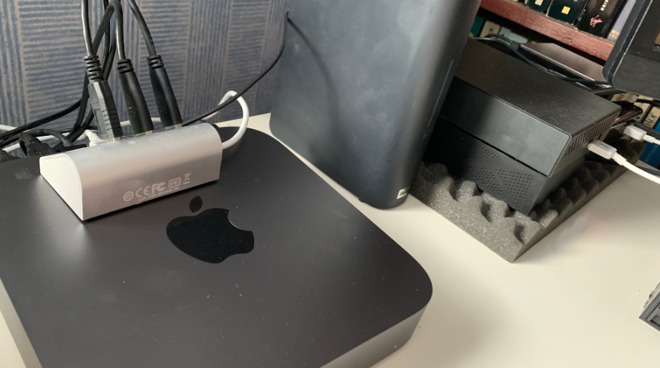
If you can't get more storage in your Mac mini, string external drives to it
It doesn't matter what anyone tells you, if you're buying a Mac on a budget then you are at least going to consider getting one that comes with only 128GB SSD storage. Maybe your budget is such that you have no other choice, but certainly you balk at spending another $200, $400 or more on increasing the storage.
Balk away, but do get that larger internal storage. If you can physically get enough cash together, go for the 256GB option as an absolute minimum. If you're not convinced, here's why you need it. And if you have already bought a 128GB machine, here's how to cope.
You lose a certain amount to macOS, and, incidentally, you'll temporarily lose much more whenever the Mac needs to update this to the next version.
Then you have to have apps and they add up. Microsoft Word on its own is over 2GB in size, for instance, but it's not an app's filesize that'll really kill you. It's the temporary space they all use while you're working. Image editors, for instance, will eat up gigabytes of temporary storage.
And that's not storage that can be managed in iCloud.
If you go below 5GB free on your SSD, macOS will nag you every few minutes, and recommend that you use iCloud to manage your files. There's a lot to be said for it, but it doesn't entirely solve the problem, it costs money to get enough space, and it can be supremely frustrating.
While Apple's Desktop & Documents feature is supposed to store your less-often used documents in iCloud, in practice when you're running out of space, it will move anything.
What's more, the Finder knows it's been moved to iCloud, but not all apps understand that and instead they think it's gone. There is little as scary as an app telling you that your most crucial document is missing.
To keep that much clear, there are many, many things you can do. And fortunately there are ways to automate it so that you don't have to keep doing it or to keep wondering where your files are.
Start with the basics. Don't keep anything you don't need to. That downloads folder, for instance, is packed with items you've dealt with, that you don't need, or that you can download again if you ever want to. So trash them.
You can do that manually, and you will do it manually when you're really pushed for space, but you can also get your Mac to do it. Choose the Finder menu, click on Preferences, and then on Advanced.
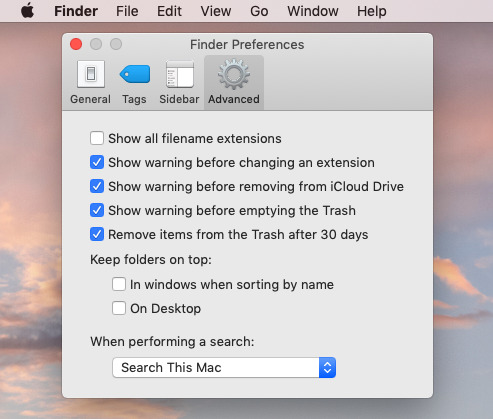
Tell the Finder to empty the trash every 30 days
Tick to have the Mac automatically delete items after 30 days.
Next, delete temporary files like screenshots. If you take a lot of these, you find they all land on your desktop and they're not huge, but they add up. When you're done with them, throw 'em in the trash.
Apple's Photos app also keeps a Recently Deleted folder. Go into that and tell it to delete everything. Certain video apps like Final Cut Pro X has a Move to Trash which does delete media, but doesn't always appear to put it in your regular trash.
Find the app's own empty trash option, if it has one, and quit it if it doesn't. Quit it anyway, and you'll reclaim some temporary storage space.
You should also restart your Mac occasionally, as that'll clear up more temporary storage space that hasn't been returned to macOS properly.
There are also caches that you can find in your hidden Library folder and you could delete those, but Apple hides that folder for a reason. We'd avoid diving in there and deleting everything we see.
Instead, we'd look to make bigger savings in space, such as exploiting how apps do not have to live in your Applications folder. They don't even have to be on the main startup drive.
You can plug in other, external drives and move your apps over to them.
You may not be in the market for any external drive, but for under $100 you can get a 2TB hard drive. For between $100-$150, you can get between 4TB and 8TB. It's a lot more space for your money than you could get internally in your Mac.
That's still not a great solution if your 128GB SSD machine is a MacBook Air, but it is possible to dock that to your drives when you're at home or at your office. Have Keyboard Maestro automatically mount when your Mac wakes or, more crucially, dismount a drive when it goes to sleep.
And if you have a Mac mini, external drives could be ideal.
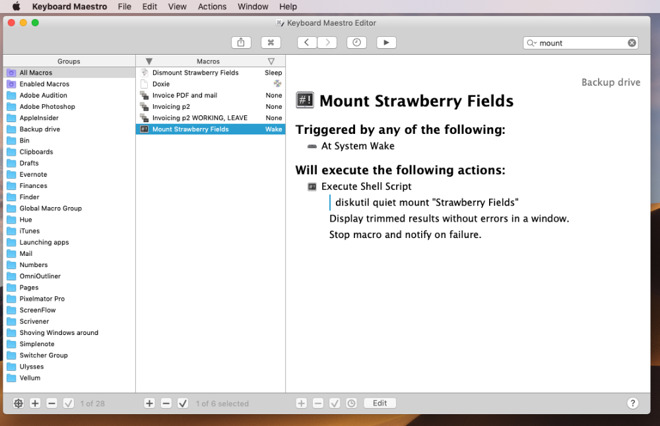
Keyboard Maestro can mount drives. It can also unmount them for you when your Mac goes to sleep, and that's handy for MacBook owners who can then safely disconnect external drives
Try to get a small external SSD, too. It'll cost you from $80 and up, but you should be able to get an SSD that's larger than your internal drive.
In that case, use it for both backup and extra storage. Get Carbon Copy Cloner to duplicate your external drive on that external SSD, and then separately set up folders on it that you use manually.
You can create a separate Applications folder on that external SSD, and drag many of your larger applications to it. Not every app will work when launched from outside the Applications folder, but most will.
Just make sure that you re-add them to your Dock after you've moved them, or the Dock will simply complain that they don't exist.
There is no point keeping your most important work files anywhere but on the Mac's internal drive.
However, you can tell many apps to use these external drives for their temporary storage. Certain image editors like Pixelmator Pro won't let you do that, but video ones like Final Cut Pro X will. And video editors use up an enormous amount of storage space while you're working.
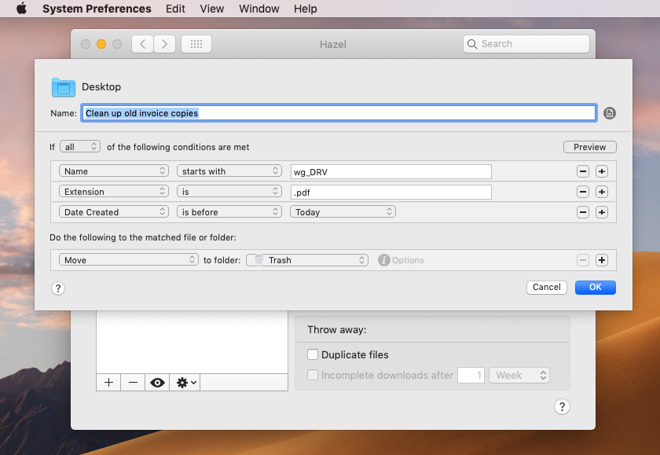
Hazel can watch for particular files and act on them
External storage, especially on hard drives instead of SSD, will be slower than your internal drive. But it'll work, and you don't have the room to be fussy.
That's the hardest thing to do, though, and the one that is most likely to bite you in the ass.
So instead of deleting them, move your documents to an archive -- on an external drive.
Every day or every week, or whenever you're up against it for space, move all your files that are over, say, a month old and drag them to your archive.
Just make sure that you also have some separate backup system. If your important document is on an external drive instead of an internal one, it's still not as safe as if you also have it backed up somewhere.
So don't do it. Get something to do it for you automatically.
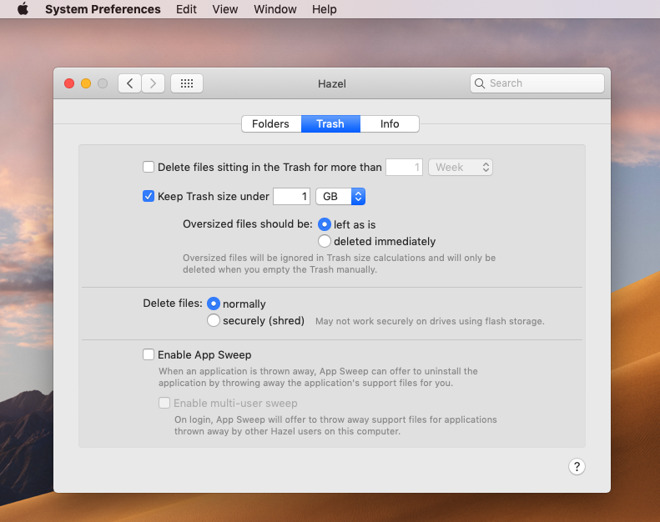
Hazel has much better controls for managing your Mac's trash than macOS does
Use the file and folder management app Hazel. Tell it to move all your files and folders that are over a month old, and it will do it. All the time. Hazel watches your Mac and acts on triggers that you tell it to, such as spotting that a document was created so many days ago.
Hazel can then delete items, copy them, move them to other folders and so on.
It's even got a special section for dealing with the Trash which is far more fine-grained than the feature in macOS. Using Hazel, you can decide to have the trash empty itself every day, if you want.
And Hazel can also automatically trash items in your downloads folder that are old, too.
There are also software options for figuring out what's taking up all your space and while it's not the prettiest or the easiest to understand, we recommend the free OmniDiskSweeper for being comprehensive and fast.

OmniDiskSweeper rapidly scans your drive and helps you spot where space is being used up
Or specifically for finding duplicate files, there's Gemini, which you can get as part of Setapp.
Yet since there are all these tools, tips and methods for dealing with small storage space, the real reason it's such a problem is how much it takes out of you.
That notification that you're running out of space will drive you spare. The way you might have, for instance, a subscription to Adobe Creative Cloud but you don't have the room to download more than one app at a time, is going to make you weep.
Once you've been through all of this space-saving, though, and you find that your Mac says you've got 20GB free space, you'll feel like you've won a lottery.
Keep up with AppleInsider by downloading the AppleInsider app for iOS, and follow us on YouTube, Twitter @appleinsider and Facebook for live, late-breaking coverage. You can also check out our official Instagram account for exclusive photos.

If you can't get more storage in your Mac mini, string external drives to it
It doesn't matter what anyone tells you, if you're buying a Mac on a budget then you are at least going to consider getting one that comes with only 128GB SSD storage. Maybe your budget is such that you have no other choice, but certainly you balk at spending another $200, $400 or more on increasing the storage.
Balk away, but do get that larger internal storage. If you can physically get enough cash together, go for the 256GB option as an absolute minimum. If you're not convinced, here's why you need it. And if you have already bought a 128GB machine, here's how to cope.
It's not enough
Yes, you're just writing the odd screenplay and doing some emailing. It's hard to imagine that work taking up an entire 128GB space -- but then you don't get the entire space.You lose a certain amount to macOS, and, incidentally, you'll temporarily lose much more whenever the Mac needs to update this to the next version.
Then you have to have apps and they add up. Microsoft Word on its own is over 2GB in size, for instance, but it's not an app's filesize that'll really kill you. It's the temporary space they all use while you're working. Image editors, for instance, will eat up gigabytes of temporary storage.
And that's not storage that can be managed in iCloud.
If you go below 5GB free on your SSD, macOS will nag you every few minutes, and recommend that you use iCloud to manage your files. There's a lot to be said for it, but it doesn't entirely solve the problem, it costs money to get enough space, and it can be supremely frustrating.
While Apple's Desktop & Documents feature is supposed to store your less-often used documents in iCloud, in practice when you're running out of space, it will move anything.
What's more, the Finder knows it's been moved to iCloud, but not all apps understand that and instead they think it's gone. There is little as scary as an app telling you that your most crucial document is missing.
Keep this clear frequently
Aim to leave 20GB free space on your Mac's SSD. That's enough to keep you out of the nagging zone even if you're working on images.To keep that much clear, there are many, many things you can do. And fortunately there are ways to automate it so that you don't have to keep doing it or to keep wondering where your files are.
Start with the basics. Don't keep anything you don't need to. That downloads folder, for instance, is packed with items you've dealt with, that you don't need, or that you can download again if you ever want to. So trash them.
You can do that manually, and you will do it manually when you're really pushed for space, but you can also get your Mac to do it. Choose the Finder menu, click on Preferences, and then on Advanced.

Tell the Finder to empty the trash every 30 days
Tick to have the Mac automatically delete items after 30 days.
Next, delete temporary files like screenshots. If you take a lot of these, you find they all land on your desktop and they're not huge, but they add up. When you're done with them, throw 'em in the trash.
Apps
This one might surprise you. Quit apps that you're not using. So many apps use temporary space and, at least in theory, that stops when you quit the app.Apple's Photos app also keeps a Recently Deleted folder. Go into that and tell it to delete everything. Certain video apps like Final Cut Pro X has a Move to Trash which does delete media, but doesn't always appear to put it in your regular trash.
Find the app's own empty trash option, if it has one, and quit it if it doesn't. Quit it anyway, and you'll reclaim some temporary storage space.
You should also restart your Mac occasionally, as that'll clear up more temporary storage space that hasn't been returned to macOS properly.
There are also caches that you can find in your hidden Library folder and you could delete those, but Apple hides that folder for a reason. We'd avoid diving in there and deleting everything we see.
Instead, we'd look to make bigger savings in space, such as exploiting how apps do not have to live in your Applications folder. They don't even have to be on the main startup drive.
You can plug in other, external drives and move your apps over to them.
External drives
Ideally, you should have a network attached storage device that lets you have multiple external drives, all backed up and all available across your network. However, if you had to buy the cheapest Mac possible, then you're probably not in the market for a NAS which, enclosure alone, can cost more than that Mac mini.You may not be in the market for any external drive, but for under $100 you can get a 2TB hard drive. For between $100-$150, you can get between 4TB and 8TB. It's a lot more space for your money than you could get internally in your Mac.
That's still not a great solution if your 128GB SSD machine is a MacBook Air, but it is possible to dock that to your drives when you're at home or at your office. Have Keyboard Maestro automatically mount when your Mac wakes or, more crucially, dismount a drive when it goes to sleep.
And if you have a Mac mini, external drives could be ideal.

Keyboard Maestro can mount drives. It can also unmount them for you when your Mac goes to sleep, and that's handy for MacBook owners who can then safely disconnect external drives
Try to get a small external SSD, too. It'll cost you from $80 and up, but you should be able to get an SSD that's larger than your internal drive.
In that case, use it for both backup and extra storage. Get Carbon Copy Cloner to duplicate your external drive on that external SSD, and then separately set up folders on it that you use manually.
You can create a separate Applications folder on that external SSD, and drag many of your larger applications to it. Not every app will work when launched from outside the Applications folder, but most will.
Just make sure that you re-add them to your Dock after you've moved them, or the Dock will simply complain that they don't exist.
Plan working storage
If you can buy external drives or if you have any old ones around your house, you can spread the load across them all -- if you plan carefully.There is no point keeping your most important work files anywhere but on the Mac's internal drive.
However, you can tell many apps to use these external drives for their temporary storage. Certain image editors like Pixelmator Pro won't let you do that, but video ones like Final Cut Pro X will. And video editors use up an enormous amount of storage space while you're working.

Hazel can watch for particular files and act on them
External storage, especially on hard drives instead of SSD, will be slower than your internal drive. But it'll work, and you don't have the room to be fussy.
Plan archive storage
Then you can also make some decisions about files that you're no longer working on. If you finish a job and you are certain that you cannot ever need its files and documents again, you could delete them.That's the hardest thing to do, though, and the one that is most likely to bite you in the ass.
So instead of deleting them, move your documents to an archive -- on an external drive.
Every day or every week, or whenever you're up against it for space, move all your files that are over, say, a month old and drag them to your archive.
Just make sure that you also have some separate backup system. If your important document is on an external drive instead of an internal one, it's still not as safe as if you also have it backed up somewhere.
You'll never do it
The trouble with this idea of moving documents around yourself is that you'll never do it. You will never remember to religiously move old documents over to your archive. And when your Mac is constantly nagging that you're running low on space, you won't easily know what documents can be archived.So don't do it. Get something to do it for you automatically.

Hazel has much better controls for managing your Mac's trash than macOS does
Use the file and folder management app Hazel. Tell it to move all your files and folders that are over a month old, and it will do it. All the time. Hazel watches your Mac and acts on triggers that you tell it to, such as spotting that a document was created so many days ago.
Hazel can then delete items, copy them, move them to other folders and so on.
It's even got a special section for dealing with the Trash which is far more fine-grained than the feature in macOS. Using Hazel, you can decide to have the trash empty itself every day, if you want.
And Hazel can also automatically trash items in your downloads folder that are old, too.
There are also software options for figuring out what's taking up all your space and while it's not the prettiest or the easiest to understand, we recommend the free OmniDiskSweeper for being comprehensive and fast.

OmniDiskSweeper rapidly scans your drive and helps you spot where space is being used up
Or specifically for finding duplicate files, there's Gemini, which you can get as part of Setapp.
It's an overhead
Yes, most apps cost money, and definitely so do external drives. When you're on a tight budget, of course these things can be too much.Yet since there are all these tools, tips and methods for dealing with small storage space, the real reason it's such a problem is how much it takes out of you.
That notification that you're running out of space will drive you spare. The way you might have, for instance, a subscription to Adobe Creative Cloud but you don't have the room to download more than one app at a time, is going to make you weep.
Once you've been through all of this space-saving, though, and you find that your Mac says you've got 20GB free space, you'll feel like you've won a lottery.
Keep up with AppleInsider by downloading the AppleInsider app for iOS, and follow us on YouTube, Twitter @appleinsider and Facebook for live, late-breaking coverage. You can also check out our official Instagram account for exclusive photos.

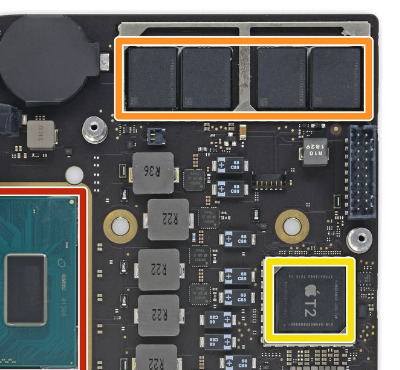
Comments
"there is a loud outcry for reliable, long-lasting, upgradeable machines. Just look at the market demand for the six-year-old 2012 MacBook Pro—the last fully upgradeable notebook Apple made. I use one myself, and I love it. Apple can do better." marco.org/2016/01/04/md101ll-a
"As we’ve progressed toward thinner, lighter, more integrated Macs, we’ve paid dearly in upgradeability, versatility, and value.”
"There is a real business impact caused by unrepairable product design.”
...and on it goes...
Apple Engineers Its Own Downfall With the Macbook Pro Keyboard - iFixit www.ifixit.com/News/macbook-pro-keyboard
"No one who has followed this Apple support document instructing them to shake their laptop at a 75 degree angle and spray their keyboard with air in a precise zig-zag pattern will quibble over a slightly thicker design.” support.apple.com/en-us/ht205662
...and in contrast:
"Everything about this device says, “HP cares.” This manufacturer wants you to upgrade and maintain this device as long as physically possible.” www.ifixit.com/News/hp-elitebook-a-friend-to-the-user
IIf there is some overarching benefit to customers in all of this it would be helpful to know. Reliability (given the keyboard-gate) and sustainability arguments would seem moot in context. Should speed depend on customer need? Would making speed/privacy (T2) and storage flexible (BTO?) for those that choose it be better?
Is there a benefit to Apple in having the most reliable data on its user base via fixed T2 drives ? Even if such data is not sold directly to others, does this build into some bigger potential agenda of parallel or future use? All Photos are now apparently tagged, with no 'off' switch, for example...?
Gaming platforms like Steam and Origin allow to store game libraries on external media, you don't need to store all games on your Mac (Preferences and save files are generally stored on the Mac though).
Life in 128 GB is not painful. We pay a shitload of money to Telco operators for their crappy LTE, spending a few bucks for extra 200 GB iCloud space is nothing compared to LTE’s cost.
Looking at the price vs what you get, the “low end” starts at $1250-$1350 for a MacBook Pro and you get a brighter screen, and 256GB.
The MacBook Air is a nostalgia rip-off.
A new MacBook owner shouldn’t immediately need to start considering external storage. If they do, they’re buying the wrong machine.
A basic external storage device (cheap) is for backups only.
HEAVY graphics users will have their NAS (network attached storage) / RAID system, but that’s another category of users and they shouldn’t be considering an Air anyway.
Apple is selling the MacBook Air to the college crowd with the knowledge it’s overpriced. First clue is they’re throwing in the Beats headphones...
Unless the MacBook Air is heavily discounted it shouldn’t be considered. The MacBook 12” (discontinued) was on sale for $850 and had 256GB, that was compelling for students...
Using/living-with one of those super-small USB keys that barely pokes out of the side?
[I know it's not USB anymore...]
Are those fast enough for apps/video to get back and forth from one of those?
Advantage that they're always there, no cables, etc.
They can't be $149 either or someone would go for the $200 bump to 256GB.
So 256GB for.... $49?
I bought a 128GB USB3 tiny-thumbdrive for $27, but it's not Thunderbolt.
Eric.
Were you collecting plates from one supplier, read/write head from another supplier, motor from the well known auto maker, case and controller from China when assembling the world’s fastest and cheapest spinning HARD DISK?!!
/LOL
For myself on the other hand, I was over 128GB on the first day. I have a huge amount of apps, a rather large Plex database, Lightroom database, large music library etc etc. 128GB would have been a disaster for me. If you are pretty certain about how you use the machine, I think it can be OK to go with the 128GB option.
So out of 1T you have 669G used and that's mostly pics. That tells me you've got too much 'stuff' on your SSD, IMHO. It mounts up because people are almost always poor stewards of storage. The more than have the more they fill it with crap. Now if people want to be lazy, that's their call. Some people might actually need more than 512G of storage, but that's rarer than most people think, because most don't know the difference between need and want. I haven't hear of anybody wearing out a Mac's SSD yet, though that may be a consideration.
But Apple doesn't need to be so proud of their SSDs, especially when fixed to the mobo. And if they insist on doing that, they could at least give us a better price on upgrades. LOL what was I thinking.
I like Grand Perspective for storage culling and it's free. http://grandperspectiv.sourceforge.net
Soldered storage is 100% A-OK. Few people will ever, ever swamp out their notebook's storage. Sure a small minority of techies will (I haven't), but normals sure as hell won't, and that's a fact.
The claim that 128GB is simply not enough storage is totally subjective. The only reason my desktop PC has a 256GB SSD is because a 128GB SSD wasn't $200 cheaper. I'm currently sitting at 48GB used on my MBA. My last MBA (a 2009 11-inch) also had 128GB storage and I never went past 80GB on it after 8-9 years. If you can't live without more storage, either pay the Apple tax, get something else, or just whine about it. Yep, Apple is definitely price-gouging on both storage and RAM, but what else is new??? My $0.02.
Another thing to keep in mind is that a lot of people nowadays get a laptop as their only computer, not as an extra, meaning they will want to keep everything on the laptop hard drive.